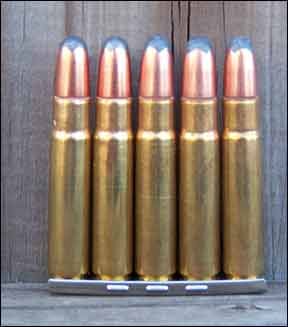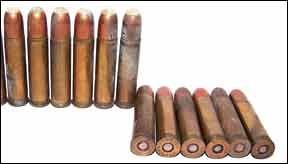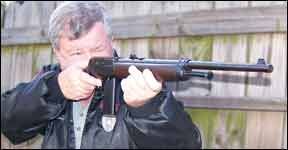Around the turn of the previous century there was a rapid advance in firearms design. Among the great changes was the popularity of self-loading rifles. While the lever-action rifle and the single-action revolver were used by Western lawmen well into the century, officers confronting armed gangs felt a need to get themselves on

a level playing field with the criminal element. A relatively short and handy self-loading rifle was just the ticket for use against thugs armed with a variety of weapons and traveling in sheet-metal vehicles. The rifles we are comparing in these pages also had sporting use, and they were used widely by outdoorsmen. But cops, federal agents, and prison guards were the primary users of these firearms. The Remington Model 8, in particular, was used by hunters, and remains popular as a Northeastern woods gun. The Winchester 1907 saw considerable military use. Several thousand were used in World War I, a drop in the bucket compared to some designs, but important for Winchester. When you look at the popularity of these rifles, an important consideration was price. Even though there were few restrictions on fully automatic weapons at the time, the Browning Automatic Rifle and the Thompson Submachinegun were very expensive. These semi-automatic rifles could be had for a faction of the price of a Thompson, but hit harder and with greater accuracy. As an example, for most of its production life from 1907 to 1957, the Winchester sold for less than $50. This is a lot of rifle for the money. Both rifles were modified with extended magazines to augment the five-round capacity of either as issued. Both rifles were blue steel and walnut, and each was popular in its day. Since they were of the same era and competed in the same market, we thought it would be interesting to compare the two rifles.
Our report is straightforward in that regard, we applied the usual Gun Tests principles. However, the ammunition problem encountered with the Winchester was an overriding concern. In its day a box of 50 rounds of the 351 was cost effective for training and outdoors use. Today the 35 Remington is widely available. The 351 WSL is scarce. As we will cover shortly, there were other calibers available in either rifle that are even more scare than the 351. Let’s look at each rifle in turn and garner our shooting impressions. A few words on the design of each—they use different operating designs but neither is a gas-operated rifle. Both are operated by recoil. Either may use cast bullets in handloads for economy. Both have a well-deserved reputation for reliability. Due to a shortage of ammunition we limited firing to 100 rounds each, but the present owner has fired the rifles extensively and he says that they “do not jam.” We agree.
We have to give a disclaimer that neither of these rifles is a first choice for a critical-use rifle today. Yet, neither has ever failed to feed, chamber, fire, or eject (except when working up lower powered handloads) and either type has an excellent reputation. The Remington was originally produced in 25, 30, and 32 Remington. They are just as expensive as the 351 WSL to obtain. The 30 Remington is basically a self-loading 30-30 WCF, while we have no experience with the others. The Winchester was also

produced in 401 Winchester, a harder hitter and even more expensive to obtain. The raters all had a ball firing these rifles, but in the end a decision had to be made. Pricing depends on the condition of the rifles, of course, but at www.AuctionArms.com and other sources, we found “Good” condition Model 8s that sold for $415 to $460, and an “Excellent” sample that went for $900. We listed $650 as a representative price because that’s what its owner said he paid for it. In our research, we found a 1949-model Winchester ’07 in 351 WSL that sold for $329. We also saw several ‘07s with reserve prices in auctions set at $500, but drawing no bids. Again, we listed the actual cost of our Winchester, $500.
Remington Model 8 35 Remington, $650
The Remington Model 8 sprang from the fertile mind of John Moses Browning. The recoil action is similar to that of the original Browning automatic shotgun. In other ways the rifle resembles a miniature BAR. Since transportation was more difficult in those days, takedown rifles were important. The Remington is a takedown rifle of an advanced type. The forend is removed by simply twisting out the captive screw that holds the forend to the rifle. Under the forend is a permanently attached lever. Screw this lever clockwise to remove the barrel from the receiver. This reduces the 41-inch Model 8 into two approximately equal sections. When the Remington is reassembled, the tightening of the lever may account for looseness in well-worn firearms. All raters appreciated this takedown and found it simple enough for even 10-thumbed shooters to use well.
To load the rifle, lock the bolt to the rear and insert five rounds into the magazine using a stripper clip. The common 8mm Mauser clip works just fine. If you do not have a stripper clip, it is not difficult to thumb the rounds into the magazine one round at a time. Let the bolt run forward to load the chamber. A caution—never allow the bolt to slam forward over a loaded chamber. This stresses the extractor and may fire the round in the chamber. Like many rifles, including the M1 Garand, the Remington features a floating firing pin. The firing pin may take a run forward and strike the primer if the bolt is allowed to slam forward on a chambered cartridge. Never drop the bolt on a loaded chamber! Once the rifle is loaded, the safety may be applied, locking the trigger and the bolt. This safety is identical to the much later AK-47 type. While independent development is possible, the AK’s inventor must have been aware of the Model 8.
Our example features the popular peep-sight option. This peep sight is raised and locked in place in preparation for firing.

Remember to lock the sight in place or it may work loose and injure the shooter. The trigger is crisp at about 4 pounds. The rifle is a joy to fire. While the 35 Remington is not a strong kicker, the automatic action somewhat lessens the recoil of the cartridge. It is not difficult to keep up a string of fire with the Model 8. The strong suit of this rifle is its ease of handling, its good balance and its excellent practical accuracy. While 100-yard accuracy is on the order of four MOA, the rifle is at its best as a short-range hard-hitting defensive piece. As a hunting rifle, the 35 Remington has proven effective against large deer, boar and black bear on many occasions. We primarily used the Hornady LeverEvolution load in testing this rifle. The Hornady load is stronger than most and accuracy is good. While ammunition is plentiful, there isn’t much choice. There is a seldom seen 150-grain load at about 2200 fps, and the 200-grain load at 2000 fps. The Hornady load actually was faster than most 150-grain loads at just over 2200 fps.
Our Team Said: Overall, this is an excellent rifle well worth its room and board. The Remington is still a viable hunting rifle capable of taking game appropriate to the 35 Remington cartridge, and that is a lot of pretty big game. The Remington and its Browning-designed recoil action and popular, readily available cartridge win out over the Winchester.
Winchester 1907 351 WSL, $500
The Winchester Model 1907 is a rifle with the looks of its era, but with smoother, more pleasing lines than the Remington. The Winchester ’07 was manufactured from 1907 to 1957, an impressively long run. The rifle differs from the Remington Model 8 in that the Winchester is a straight blowback. The bolt recoils off of a fixed barrel, while the bolt, bolt carrier and barrel of the Model 8 recoil together. As a result the Winchester has roughly the same recoil as the Remington although the Winchester is both heavier and less powerful. The rifle is a combination of period features along with surprisingly modern features as well.
The ’07 features a cocking rod mounted under the barrel. This rod features a knurled knob that is easily manipulated. You first load the detachable magzine and lock it in place. By pressing the rod to the rear the bolt is cocked. To lock the bolt to the rear, the rod is twisted to one side. There is also a counterbalance to the bolt in the forend that aids in operation. While it seems complicated in explanation, the rifle is simple enough to operate. Once cocked, the rifle is made safe by means of a cross-bolt safety just ahead of the trigger. This safety is much handier than the Remington.
There were 10-round magazines produced for the Winchester, and

they now bring some $100 or more when found. We were surprised to find Winchester 1907 magazines for sale at Triple K Manufacturing. Triple K is a great resource not only for modern magazines but the only resource for many older magazines. Triple K offers both 5- and 10-round magazines for this rifle. With original 10-round magazines almost impossible to find even at scalper prices, the Triple K magazine is very attractive. Ours proved reliable in firing hundreds of rounds with a minor modification of the magazine to ensure the bullet nose fed dead into the chamber. We had to shave a little metal off the rear of the magazine and bend the lips just a little. This is a well designed, robust magazine that places reliability over capacity. In its day—and with the original Winchester magazine—the Winchester offered 10 shots pretty darned quick. Finding ammunition for this rifle isn’t easy. Original Winchester or Western loads are occasionally found for sale at around $60 to $100 for a box of fifty. Their storage condition means everything, but they are still old production. We were able to find two boxes of Western ammunition for sale at America’s shopping place, the gun show. The earlier examples had verdigris and looked rugged. The second box was pratically as new. $65 for the first box, $75 for the second.
Introduced in 1907 for the Model 1907 Autoloading Rifle, the .351 WSL (Winchester Self-Loading) has a jacketed bullet diameter of .351 inch, not the standard .357-.358 inch used by modern 35-caliber cartridges. Winchester offered .351 WSL factory loads loaded with 180-grain jacketed soft point round nose bullets. The muzzle velocity was stated to be 1850 fps, and the muzzle energy 1370 ft.-lbs. from a 20-inch barrel. The 351 WSL looks like a somewhat larger version of the 30 Carbine round, although the 351 is more powerful. The rim diameter is .407 inch and the head diameter is .380 inch. Cartridge overall length is 1.90 inch. It is based on a semi-rimmed, straight-sided case 1.380 inches long. Because of the handy Winchester ‘07 carbine, the .351 cartridge enjoyed a long production life. The Model 07 was discontinued in 1957 and 351 WSL ammunition was offered for several years after that.
Graf and Sons offers loaded ammunition at a fair price. We have also used ammunition from Bob Shell’s Obsolete Ammunition. The majority of the loads fired in this rater’s rifle have come from Load X ammunition. They also supply a trove of other obsolete rounds and are a great resource for those of us that like to make the old guns go bang. As an example of the difficulty in finding ammunition, Bob Shell is the expert and his loads work just fine.

The case must be handmade from .357 Maximum brass by cutting away the case rim and then cutting in an extractor groove. Then the bullets used must be swaged down from the common .358 inch for the .35 Remington and .357 Magnum cartridges to the Winchester’s unique .351 inch diameter. This isn’t something the average hobbyist will wish to attempt. Prices vary for this custom ammunition but the average is about a dollar and a half a round and well worth the price. Once you have a few brass cases built up Bob will load them for you at a reduced price. This is a lot of trouble to fire an underpowered old rifle, but you either have the bug to shoot the Winchester or you do not. If you are willing to negotiate the search, ammunition isn’t that difficult to find and the loads we tried, from Shell and Load X, worked just fine. The rifle is pleasant to fire, but the recoil is about the same as the more powerful Remington Model 8 due to the blowback action of the Winchester. It is not unpleasant, not up to 30-30 standard, but certainly feels odd. We are able to keep up a faster cadence of fire with the Winchester and the availability of the 10-round magazine is a big plus. The Winchester is quite accurate at close range, as many blowback-operated actions are. The barrel is fixed and very rigid. It is no mean feat to produce a 2-inch 50-yard group with good quality ammunition.
Our Team Said: The Winchester rifle hangs on the target and delivers good accuracy. The trigger action is heavier than the Remington, and not as consistent. It varied by a half pound. Whether a mark of the breed or not, we have no reference. The Winchester certainly has merit as a defensive rifle and would probably have been the first choice at the time as a cop and guard gun, and many were used for that purpose. The 10-round magazine is a good option. There were once gunsmiths who modified the Remington for an extended magazine, but we have never seen an example. But hassle is part of owning an older gun like this one, and for our testers, the relative ease of obtaining 35 Remington ammo instead of the 351 WSL was a huge advantage the Winchester couldn’t overcome.
0411-CLASSIC-POLICE-ACC-CHRONO-DATA.pdf
0411-REMINGTON-MODEL-8-SELF-LOADING.pdf
0411-WINCHESTER-1907-351-WSL.pdf

























